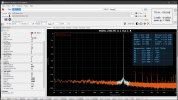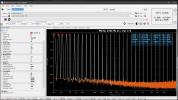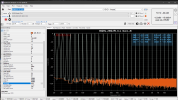Rohm DACs have a direct DSD mode. Fixed DAC mode and DSD input necessary and you can bypass the SDM. There is no pcm conversation.
Thanks for info, I was just reading about that in this thread:

audiophilestyle.com
But I didn't find this nice block diagram!
I was just starting to look around and you came just about at the right time

I see there's a reasonably priced and decently performing SMSL D300 using it.
It also has a Preamp mode but I wonder if it really is bypassing volume control for DSD.
Anyone knows?
It could be something to try...
From what I've read in that thread it's basically impossible to tell if the ESS is doing conversion to PCM or not.
It's a black box and they will not tell.
Volume control in DSD domain seems possible, doesn't necessarily mean it's being converted to PCM.
What is agreed to be a concern is the ASRC and the modulators...
I was able to download the mentioned technical paper on the Sabre DAC internal operations via the Wayback machine.
I'm still reading it but it seems to me they are something very peculiar.
Our modulators
differ in detail from conventional ΣΔ modulators in that they
can operate up to 100% modulation depth. This is achieved by
a cascade of independently stabilized lower-order modulators
The modulator is fifth order with
adjustable (user software configurable) output bit width,
typically six bit, and since it operates to 90% modulation
depth and at rates up to 40Mhz, the noise floor from the
modulator is well below −160dB (the integrated noise is less
than −140dB).
From what I understand reading there's an n number of 6-bit 40 MHz modulators in parallel/serial/mixed configuration?
They also talk about the I2S and DSD data streams and the fact they oversample "as much as 40 MHz" the incoming data.
Which seems to be the reason they need the ASRC in the final stage before the modulators.
Rather than trying to lock a PLL to the data rate of this
interface signal, the Sabre DSP uses the arrival time of the
data as a gating signal for the first part of the processing.
Specifically, we now need to apply a filter to the digital data –
we must remove the image that will be created when we upsample
the data to our much higher clock rate.
The Sabre DAC rate converter has two advantages compared to the
poly-phase filter approach and is described in great detail in
the pending patent. Firstly the rate conversion is unlimited –
allowing the Sabre to always achieve a conversion into its
exceptionally high clock rate (as much as 40Mhz) from as
little as 4Khz in one step; and secondly, the process is
essentially perfect to the bit level – the output DNR exceeds
175dB and the THD is correspondingly high.
As well as sample rate conversion the Sabre has a
proprietary jitter reduction circuit that operates with the rate
converter and is able to achieve a 100% jitter rejection. These
two steps: jitter rejection and rate conversion; are able to take
the “burst” mode over-sampled filter output into the precisely
correct clock edge of the high speed clock. Audio data from
all sources is now in the high speed clock domain and sent to
the modulator.
Maybe there's some more info on the patent mentioned but I doubt it:
To understand how ESS modulators may differ from more conventional
ΣΔ modulators refer to US Patent 7,058,464 which describes one difference.
Other innovations are not publicly disclosed – they are retained as ESS
Proprietary information.
Most of the important stuff it's probably undisclosed.
Not sure if this is this a good approach but it's definitely interesting...
Anyway I tried to test with the scope mentioned in that thread and made some sine test tones at very high frequencies.
I'm using now the Topping D50s, which btw I like it very much considering the 100€ something I paid for on Amazon 2nd hand.
Perfect for my needs and it also has the socketed op-amp which is nice for experiment.
I'm just puzzled at the very low voltage level on the line-out which is 120-150 mV below the Aune X8.
Not sure it's normal...
The D50s doesn't have a selectable fc for DSD unfortunately.
But at least I can tell that if there's a conversion to PCM, it's using at least an fs at or above 768 kHz

Tried to use Aul Converter to create some DSF test files but it just produces an empty file...
I had to use the DSD Processor and it's limited to 768 kHz.
If someone has some professional equipment that can produce DSF files from very high-rate PCM (1,5-6 MHz), I'd appreciate some test tones assets at different very high frequencies.
In theory with DSD512 native the DAC should be able to reach 22 MHz and if something comes out I should be able to see it.
Depends on how the IIR filter is cutting off but it seems to be very relaxed... a DSD512 test tone at 380 kHz is read at 270 kHz on the scope.
I have verified that I can see at 768 kHz both with Filter 5, fast roll-off linear phase, and Filter 3, fast roll-off minimum phase, a 380 kHz test tone.
If you really care about entertaining your dog with hi-res music then PCM 768 kHz is the way to go

Jokes aside, I got a bit worried while testing.
Forgot to disconnect the R output from the amp and left the speakers enabled.
At some point I realized that I could hear the test tones.
I didn't expect it to reproduce anything considering they were all above 150 kHz.
Also I can't hear anything above 13 kHz, pretty sure.
Guess it's just aliasing?
Fortunately it didn't damage my AMT tweeters, was a bit worried...

www.audiosciencereview.com








